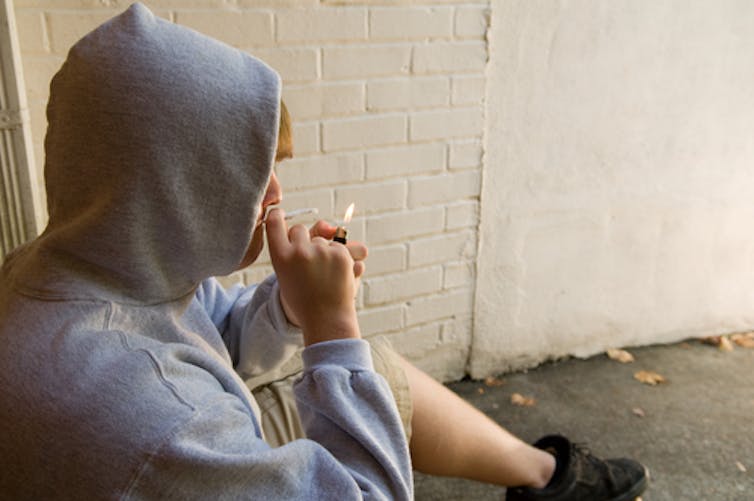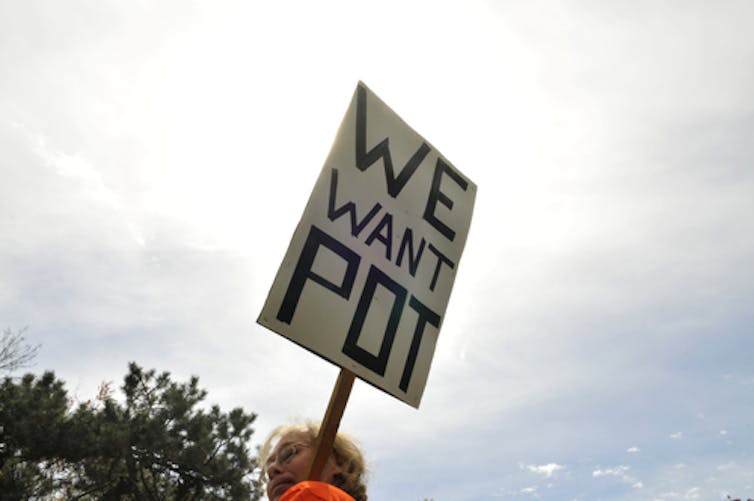Cannabis use in teens not a gateway to conduct problems, study suggests – but risks still exist
- Written by Dan Romer, Research Director, Annenberg Public Policy Center, University of Pennsylvania
With the legalization of cannabis for adults becoming increasingly widespread[1], more adolescents will be trying the drug. And parents will be wondering what the consequences will be for their teens should they try and continue to use marijuana.
A few decades ago, there was considerable concern that cannabis use was a gateway to more serious problems, such as socializing with drug-using peers and delinquent behavior. In fact, a study of a large cohort[2] of youth in New Zealand in the 1990s suggested just such an outcome.
More recently, my research colleagues and I were able to ask whether this applied to teens today in the U.S. Our study[3] involved following 364 adolescents living in Philadelphia over eight years, starting when they were between 10 and 12 years old. We conducted five annual surveys and a final follow-up survey when they turned 18 and 19. Using a more sensitive statistical methodology than had been used in the past, we were able to disentangle the effects of which came first: conduct problems or marijuana use. And we found some interesting patterns.
Our study showed that users of marijuana do not seek out other users. In addition, we found no evidence that use of cannabis led to greater problem behavior. Instead, we found that the teens who reported changes in their problem behavior were more likely to subsequently increase their use of cannabis. And they were also more likely to begin associating with peers who also used the drug.
This was different from other marijuana users who did not develop new friends who used marijuana. They were more likely to start using marijuana if their friends already used it, which was not a surprise. But there was no evidence that marijuana use led to the development of potentially deviant peer relationships with youth likely to engage in problem behavior.
Teens and cannabis use
 A teenager smokes a joint. Some teens in a recent study developed a marijuana use disorder.
threezrocksimages/Shutterstock.com[4]
A teenager smokes a joint. Some teens in a recent study developed a marijuana use disorder.
threezrocksimages/Shutterstock.com[4]
The study[5] tracked subjects’ use of cannabis as well as other drugs. In addition, the study asked them about whether they engaged in various types of problem behavior, such as stealing and skipping school. We also asked about their friends’ drug use, and at the final follow-up, we probed for symptoms of substance use disorder stemming from their use of cannabis and other drugs.
At the final follow-up[6], about 40 percent of the adolescents who continued to use marijuana reported having developed a mild cannabis use disorder, showing signs of two or three symptoms, such as craving the drug and feeling the need to use it. We were not surprised that the teens who had behavior problems were more likely to develop the disorder, and our cohort was more likely to include this high-risk group than nationally representative samples. Thus, the likelihood of acquiring even a mild disorder from marijuana use is probably much lower.
But even the teens without behavior problems were susceptible to developing the disorder.
Nevertheless, there was no evidence that use of cannabis led to the development of conduct disorder or to more serious use of other drugs; all of the evidence pointed to the reverse.
This suggests that the prior findings may have been due to the failure to examine the effects of problem behavior on cannabis use. It may also reflect changes in how the drug is used in today’s more accepting environment.
Cannabis not the risk some fear?
 A rally in October 2012, in favor of legalizing marijuana. The plant and its active ingredient still carry risks.
arindambanarjee/Shutterstock.com[7]
A rally in October 2012, in favor of legalizing marijuana. The plant and its active ingredient still carry risks.
arindambanarjee/Shutterstock.com[7]
In one sense, these findings are reassuring. They suggest that greater access to cannabis need not have the deleterious effects once feared.
Yet cannabis is still a potentially addictive substance, just as alcohol and tobacco, the other drugs that many adolescents are likely to try. And despite the use of these popular drugs, there was very little evidence of gateway effects to harder drugs, such as heroin or other opioids. The gateway hypothesis regarding adolescent drug use has lost a lot of its credibility following more careful research[8] on the effects of the drugs that adolescents are likely to try. Indeed, youth who use one drug are also likely to use others, as opposed to one leading to another. And as we found, substance use disorders tend to cluster across drugs.
As noted above, teens with friends who used cannabis were also more likely to start using the substance. This suggests that as the drug becomes more available, it is likely to spread through peer networks, just as alcohol does now[9] despite it being restricted in sales to those over age 20.
And this further suggests that there will likely be more cases of substance use disorder attributed to cannabis. Based on our teenage cohort’s experience with alcohol, we estimate that less than 25 percent of youth who use alcohol consistently will develop a mild case of alcohol use disorder. It would not be surprising if the same thing happens as cannabis becomes more available.
Cannabis not harmless
Our findings suggest that cannabis is not a harmless drug, and policymakers and parents should proceed with this awareness as it becomes more available. Youth who are susceptible to psychosis[10] are playing with fire when using strong doses of the drug. And parents may not know if their teen is susceptible.
Evidence to date in the states that have legalized marijuana for recreational use suggests that motor vehicle fatalities due to crashes do not increase[11] post-legalization. However, there is some evidence that it may lead to more non-fatal crashes[12].
On the other hand, cannabis is increasingly recognized as an effective pain killer[13] for many who suffer from chronic conditions, and the states that have legalized medical marijuana have experienced a decline in prescriptions for opioids[14].
But the connections between cannabis and opioid use are complex. There is some evidence that use of cannabis in adults can lead to greater use of opioids[15], but this too is older research which may not reflect the medical use of the drug. Determining the overall benefits of cannabis will continue to be a subject of research.
All of this evidence points to the increasing recognition that cannabis is incorrectly labeled as a Schedule 1 drug by the U.S. government, along with heroin, LSD and ecstasy. This classification designates cannabis as having “no currently accepted medical use and a high potential for abuse.” Considerable experience along with the growing consensus of the medical community suggests that this conclusion is no longer tenable.
Our study also suggests that fears about the drug’s potential gateway effects in causing harms for adolescents have been exaggerated. A sound policy going forward will require a balanced appraisal of both its benefits and harms.
References
- ^ widespread (www.governing.com)
- ^ study of a large cohort (www.ncbi.nlm.nih.gov)
- ^ study (doi.org)
- ^ threezrocksimages/Shutterstock.com (www.shutterstock.com)
- ^ study (doi.org)
- ^ follow-up (doi.org)
- ^ arindambanarjee/Shutterstock.com (www.shutterstock.com)
- ^ more careful research (www.oxfordclinicalpsych.com)
- ^ alcohol does now (journals.plos.org)
- ^ susceptible to psychosis (www.nature.com)
- ^ do not increase (ajph.aphapublications.org)
- ^ may lead to more non-fatal crashes (www.iihs.org)
- ^ effective pain killer (www.nationalacademies.org)
- ^ decline in prescriptions for opioids (doi.org)
- ^ greater use of opioids (doi.org)
Authors: Dan Romer, Research Director, Annenberg Public Policy Center, University of Pennsylvania

